What Is the Ecommerce Customer Experience?
The ecommerce customer experience (CX) encompasses every interaction a customer has with your business or brand.
It begins the moment they come into contact with your brand. And continues even after they buy something from you.
It can start with a Facebook post, progress to your website, and continue with a post-purchase email marketing campaign. This entire process is referred to as the buyer journey.
And every touchpoint within that journey is part of the customer experience.
Regardless of the type of ecommerce business you have, three distinct parts of the customer journey influence customer experience.
Pre-Purchase Experience
The pre-purchase experience begins before a consumer makes a purchase. It can start as early as a social media post or a Google search result.
Every interaction with your brand from that moment on is part of the pre-purchase experience.
This is why it’s imperative to know your audience well. Whether they accidentally stumble upon your content or specifically seek you out, your branding needs to speak to them. If your content piques someone’s interest, your website design and messaging need to keep it.
Specific tactics can help move leads through the funnel.
Like these:
- Engaging storytelling: Use your website, blog, and social channels to share stories about how your products are made, the people behind them, and positive customer experiences
- A compelling value proposition: A clear statement that explains how your product or service solves a customer’s problems or improves their situation
- Personalized content marketing: This could involve recommending products based on past browsing or purchase history, customizing email marketing campaigns, or adjusting website content to match a visitor’s profile
- User-generated content (UGC): Content created by actual customers is authentic and compelling
Zappos is an excellent example of a brand that uses storytelling and UGC well. On Instagram, Zappos posts relatable running videos.
Purchasing Experience
The purchasing experience is the time between when a new prospect lands on your website and completes a purchase.
Your goal is to make it easy for them to find what they want. And check out with zero hassles.
The following elements can help improve the purchase experience:
- Effortless navigation on your website
- Clear product categorization
- Intuitive search functions
- A healthy cross-section of product reviews
- Well-organized product pages
- Informative product descriptions
- Easy-to-find transactional information
Amazon is a good example of a seamless purchasing experience. There’s a reason they have an 89% customer loyalty rate.
Visitors can easily find what they’re looking for. And Amazon creates a personalized experience with product recommendations, upsells, and cross-sells.
When you log in, Amazon creates curated shopping suggestions based on your purchase history. So, if you often buy pet supplies, you may see suggested items for your furry friend.
Amazon will also suggest purchases based on items saved to your wish lists.
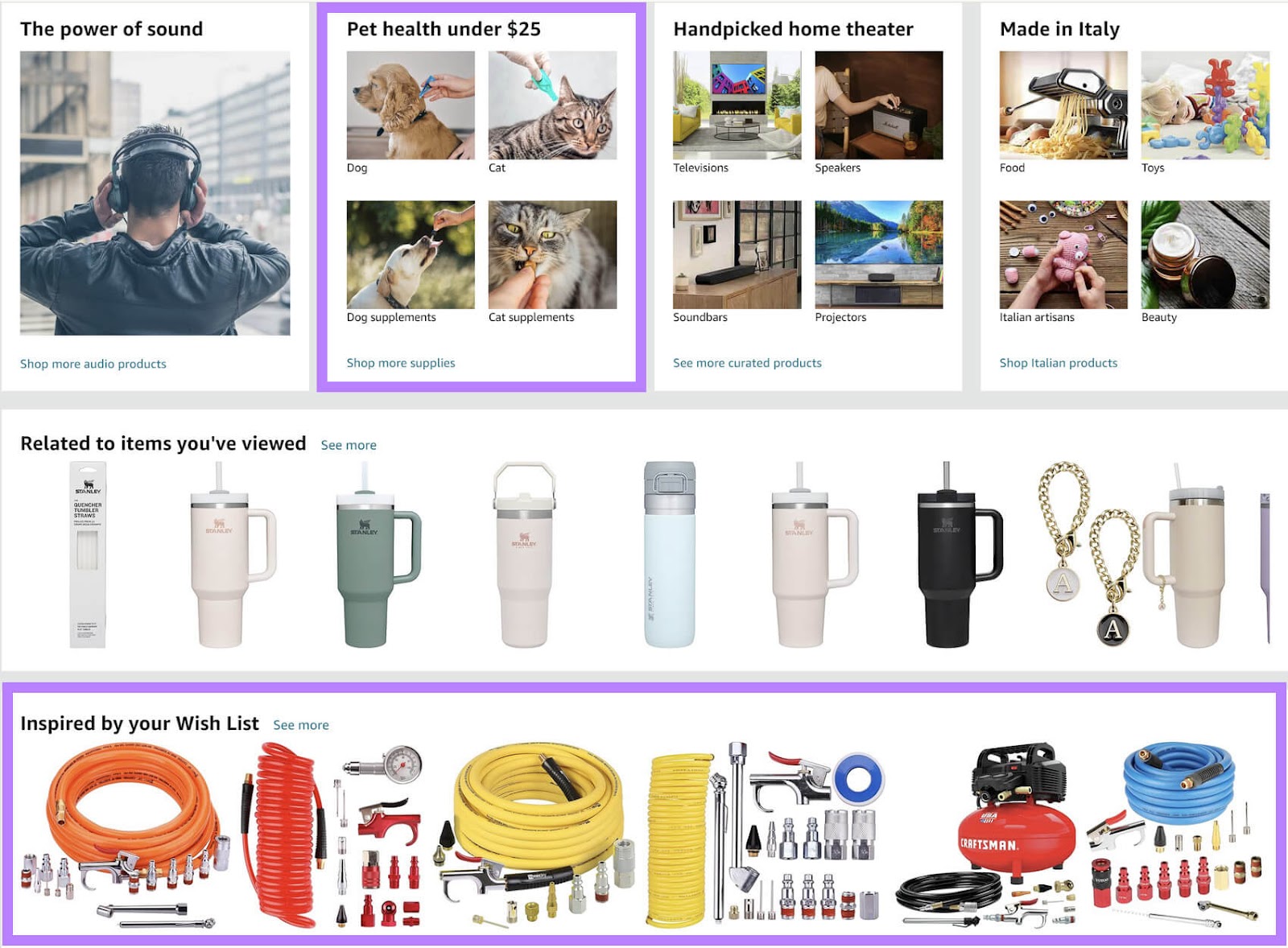
This flawless experience needs to extend to the actual transaction—a common sticking point for many ecommerce brands.
A clunky checkout flow can negatively impact conversion rates when customers don’t get the expected experience.
For example, customers may be deterred from purchasing if they’re met with a multi-page checkout or mandatory account creation.
Post-Purchase Experience
The post-purchase experience is a chance to exceed expectations. And turn a one-time shopper into a loyal customer.
Keeping customers informed can contribute to a positive post-purchase experience.
This includes:
- Prompt order confirmations
- Transparent shipping information
- Hassle-free returns process
For example, consider Zappos’ shipping and return policies. Their customer support team has single-handedly built a cult-like customer base.
Their free shipping and 365-day return policy have set a benchmark for post-purchase excellence.
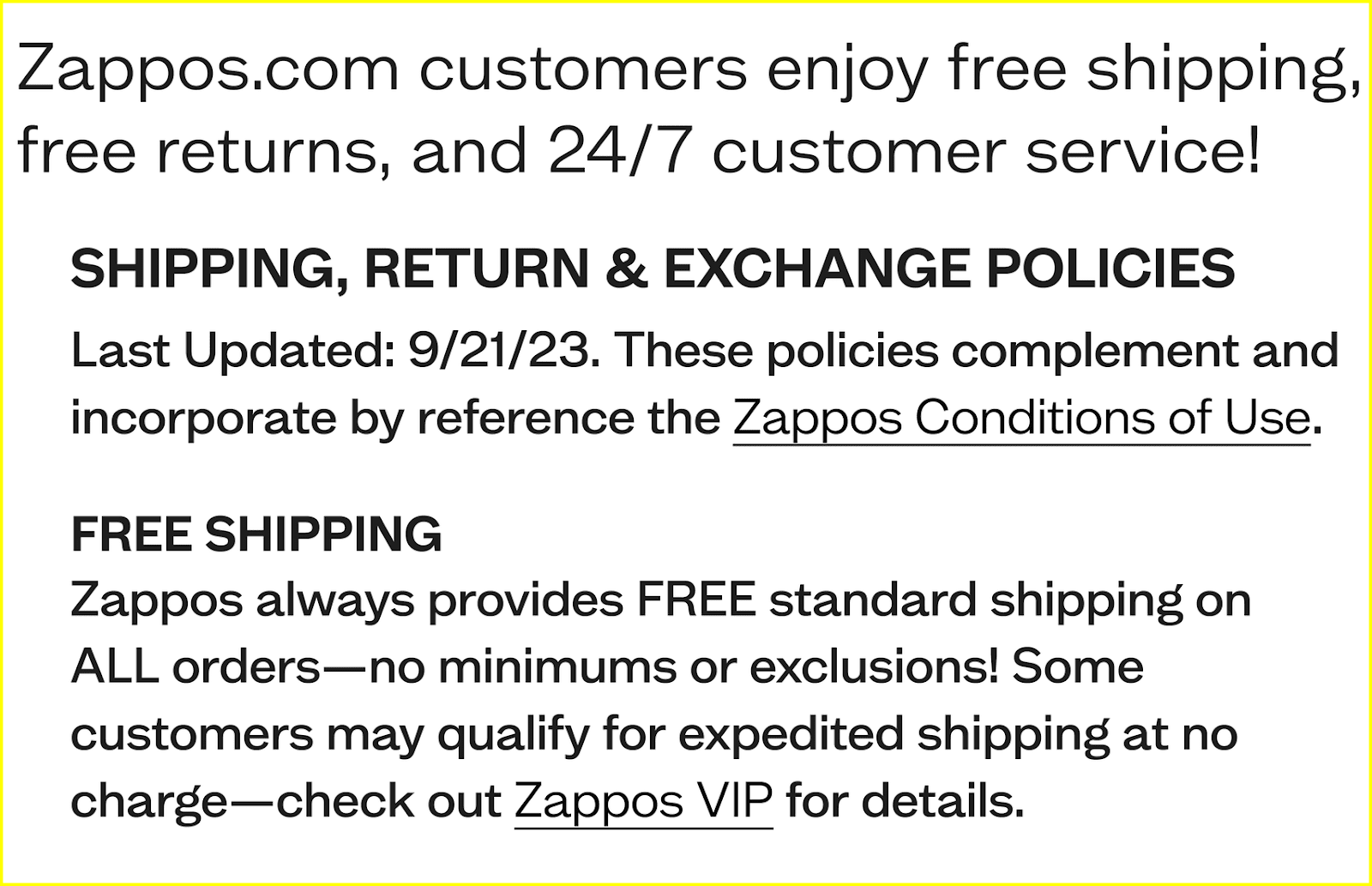
The post-purchase experience should also include marketing communications. Give customers a reason to buy again by sending a mix of informative and promotional content via email. And using social media to keep your brand top of mind.
Further reading: Ecommerce SEO: A Simple Guide for Beginners
How the Ecommerce Customer Experience Impacts Your Business
Finding ways to make your ecommerce site stand out is crucial. One of the best ways to accomplish this is a stellar customer experience.
The ecommerce customer experience can directly influence many parts of your business.
This includes:
- Customer retention: A positive experience will leave your customers satisfied, more likely to buy again, and less sensitive to price changes or minor mistakes
- Brand loyalty: Exceptional CX fosters a strong emotional connection to your brand. And can lead to increased customer loyalty.
- Conversion rates: If customers find it easy to navigate your site and make purchases, they’re more likely to complete a transaction
- Competitive advantage: Offering a superior customer experience can help you stand out from competitors. And attract more customers.
- Reduced costs: Efficient customer service and a well-designed user interface can reduce the need for extensive customer support
- Overall revenue: Happy customers are more likely to make repeat purchases. And recommend you to their friends, directly impacting your bottom line.
- Market growth: Exceptional customer experience leads to a strong ecommerce platform that can open up more opportunities to expand your product offering and enter new markets
- Brand reputation: In the age of social media and customer reviews, too many bad experiences can significantly damage your brand’s reputation
Starbucks’ loyalty program is a great example of excellent customer experience. Although they are a brick-and-mortar, their mobile app accounts for about 50% of all sales.
Through the app, Starbucks customers can order their favorite beverage, receive personalized recommendations, and skip the line at the store.
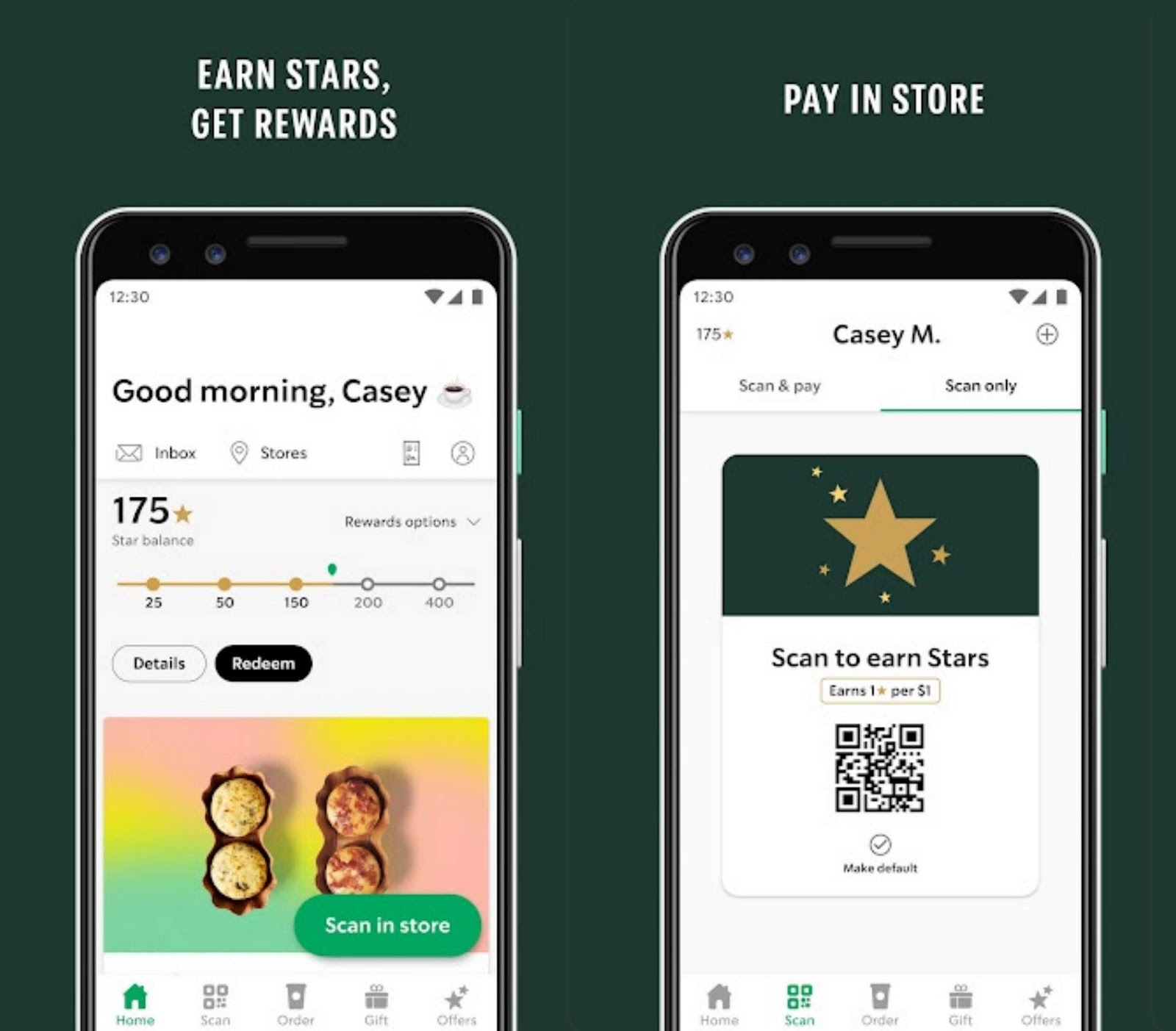
Image Source: Starbucks
How Is the Ecommerce Customer Experience Measured?
Measuring the ecommerce customer experience requires understanding various metrics. And key performance indicators (KPIs).
Focusing solely on conversion rates as a measure of success might be tempting, but there’s more to it.
The following three KPIs can show you what you’re doing well. And point out opportunities for improvement.
Net Promoter Score (NPS)
NPS measures the likelihood that customers will recommend your brand to their friends and family. It’s simple to use. And helps quantify how online shoppers feel about your brand.
An example of how you might use NPS is a post-purchase survey asking shoppers how likely they are to recommend your brand.
You can use these metrics to find happy customers more likely to leave positive reviews, join a loyalty program, or promote your brand on social media.
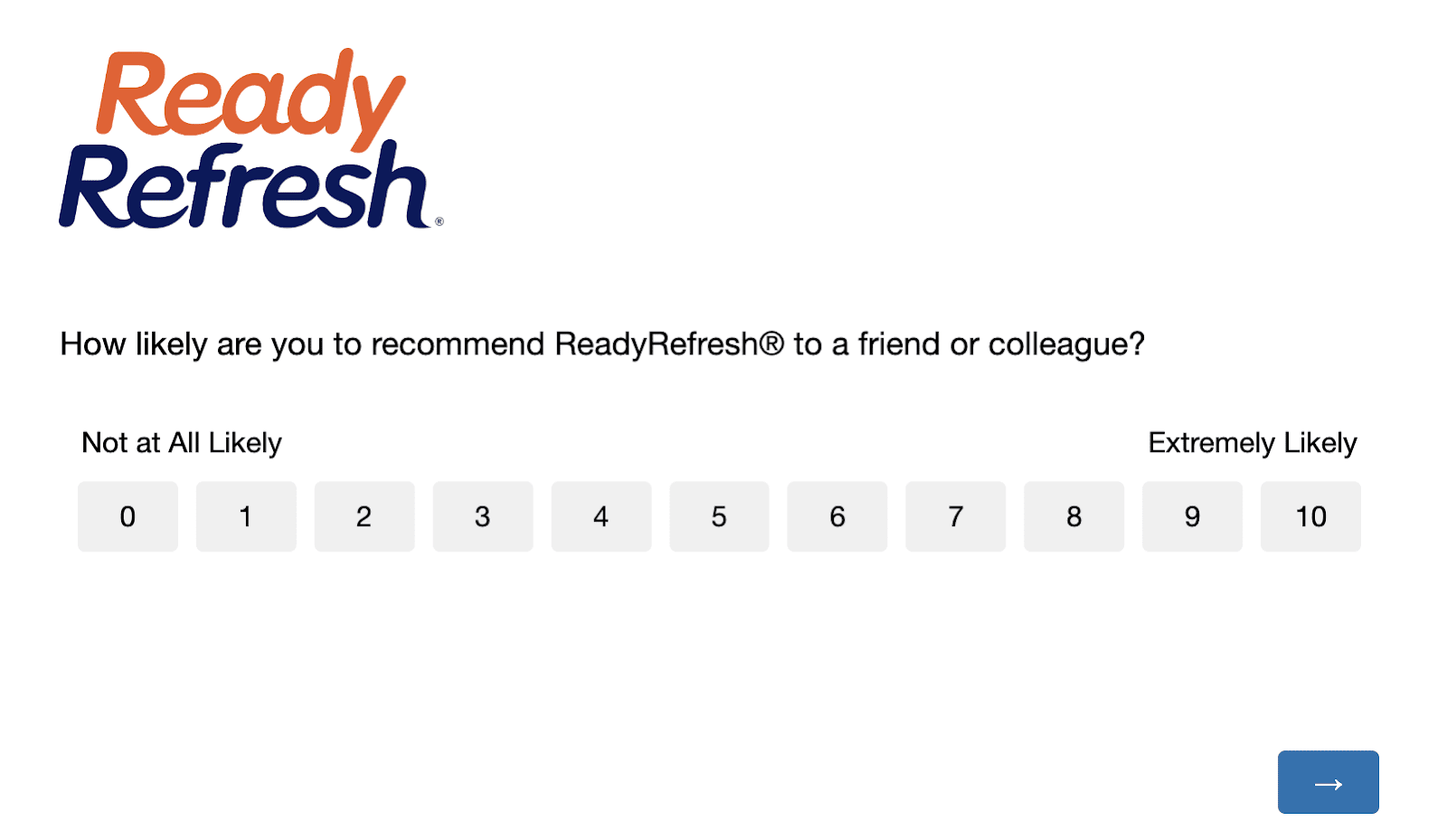
Customer Satisfaction Score (CSAT)
CSAT measures customer satisfaction. It provides real-time feedback on interactions like customer support, checkout, or product delivery.
For example, after a customer chat support session, you could send a quick survey asking customers to rate their satisfaction.
If you see low scores, you know there’s a problem to fix right away. Staying on top of issues like this will help to keep customers happy.
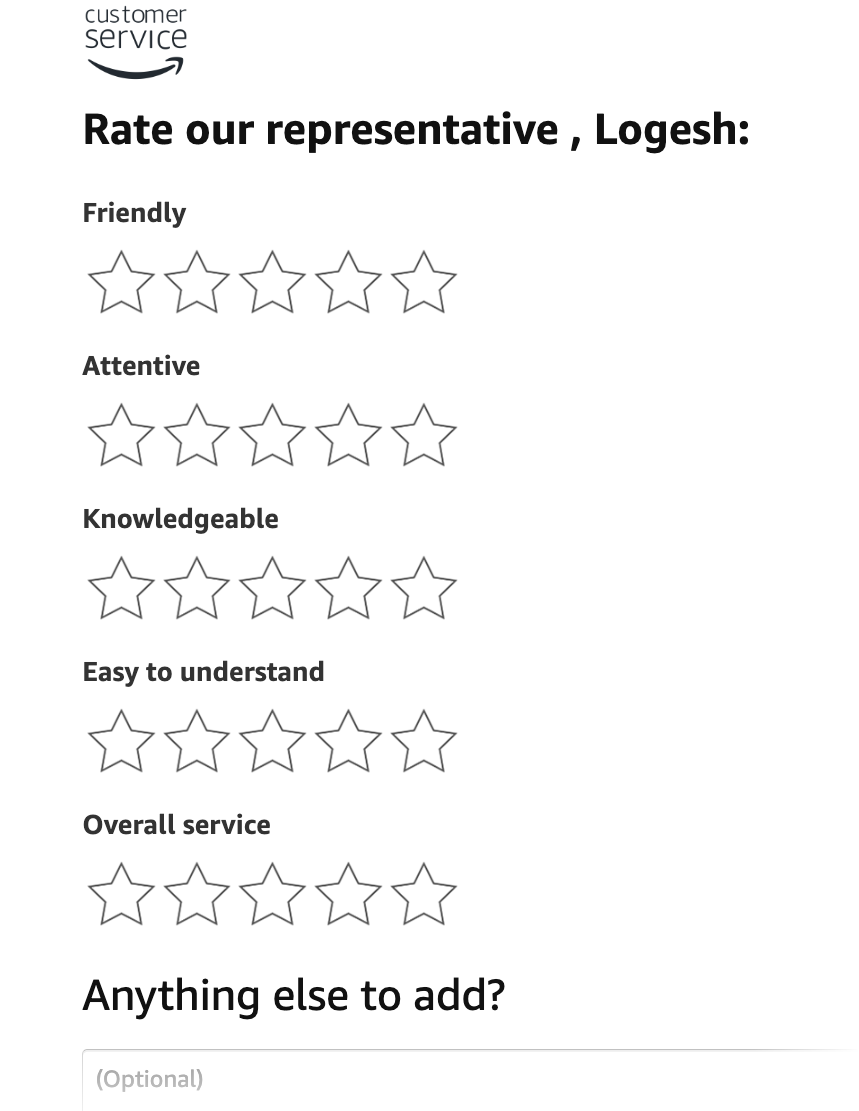
Customer Effort Score (CES)
The Customer Effort Score (CES) measures how easy it is for customers to complete an action. Like returning a product or finding information on your website.
Let’s say you ask customers to rate how easy it was to return a product. A low score means it’s easy. A high score means it’s hard. And the return process needs simplifying.
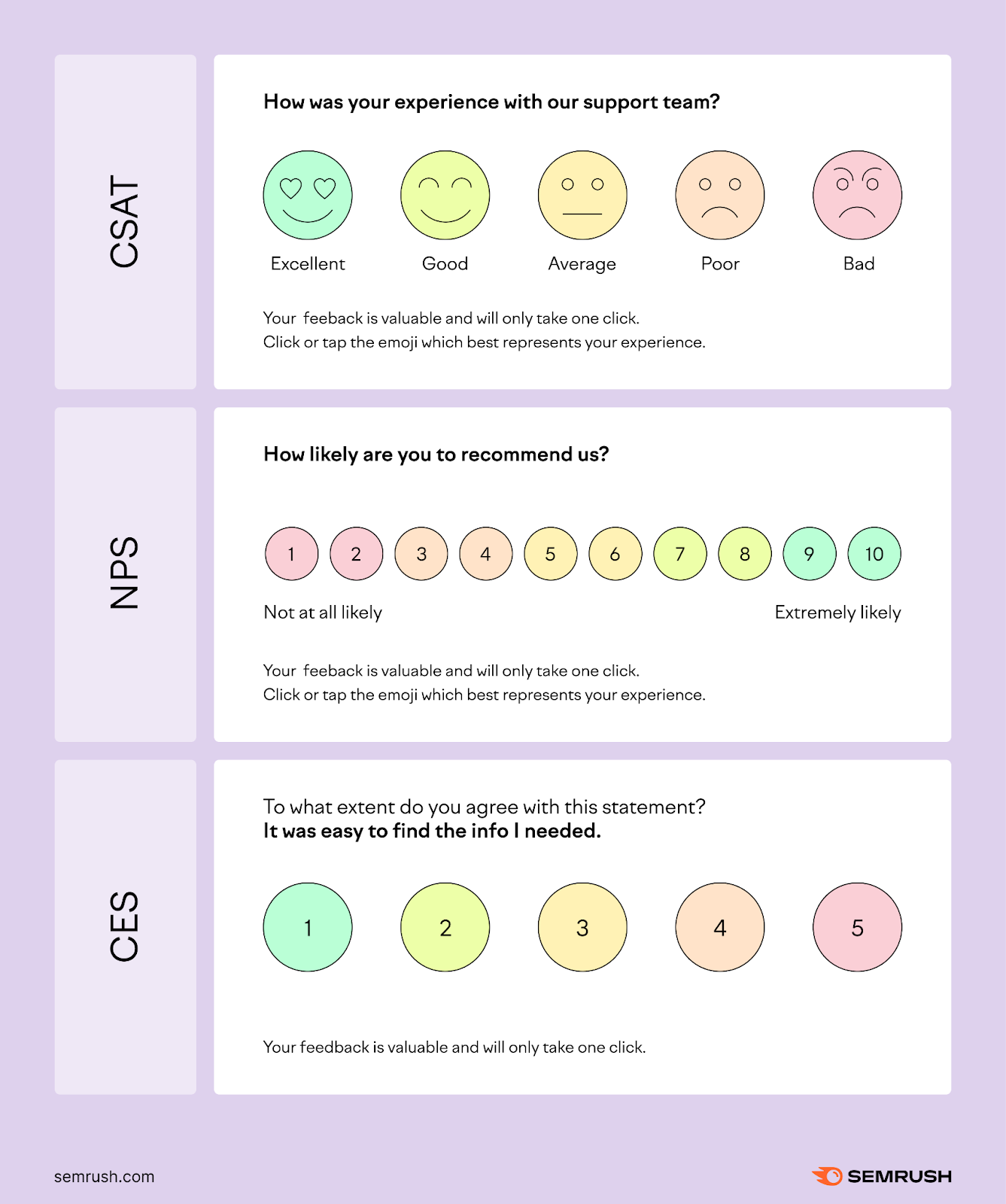
Strategies for Improving the Customer Experience
A better customer experience can help attract more customers. And increase customer lifetime value.
Here’s how to improve ecommerce customer experience:
1. Design a User-Friendly Ecommerce Platform
A user-friendly ecommerce platform is critical for customer engagement.
Sixty percent of customers are more likely to click away from a poorly designed website. Regardless of what grabbed their attention in the first place.
A consistent experience is essential to keep customers engaged. This requires designing your website with user experience (UX) in mind.
The following can contribute to a better UX:
- Clutter-free layout
- Clear navigation
- Mobile responsive design
- Homepage customization
Nike’s homepage is a good example of a clear and clutter-free layout. They offer several options to find what you’re looking for. You can shop by sport, style, gender, and more.
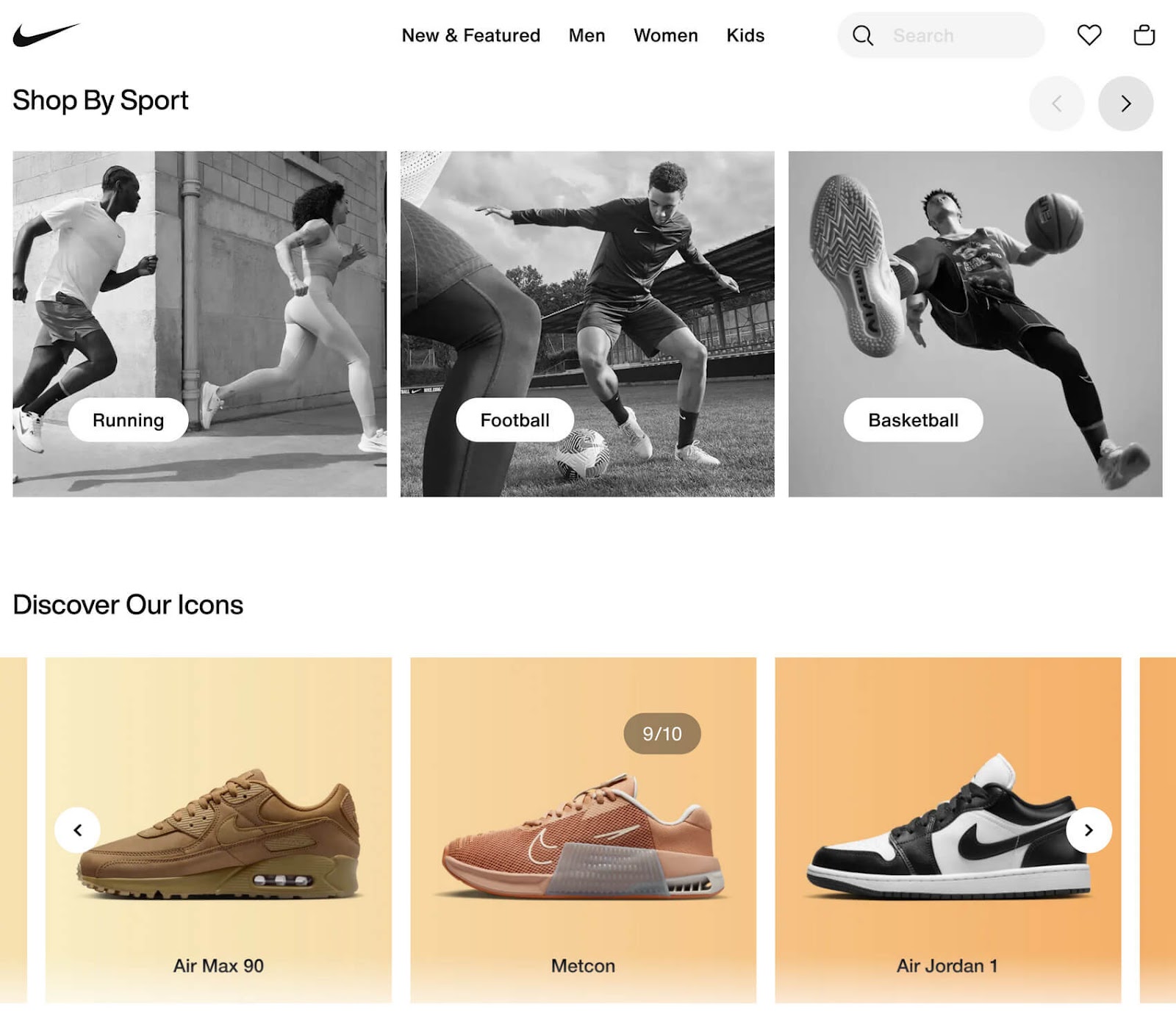
Aside from the obvious, like happy customers, a user-friendly website may also positively impact search engine results.
When shoppers stay on your page, return to it frequently, and make purchases, it signals to Google that your website is useful. And since Google wants its users to have a positive experience, this can help influence your rankings.
2. Use Data to Create Targeted Content
According to McKinsey & Company, 71% of online customers expect a personalized shopping experience. And 76% are easily turned off if they don’t get it.
Using artificial intelligence (AI) to collect customer data can help you deliver a better online experience. And meet or exceed customer expectations.
These tools can help you analyze things like purchase history, browsing behavior, and demographic information. To offer targeted product recommendations and customized content.
Let’s say you sell outdoor clothing. A research tool like One2Target can help you get to know your audience better. And the better you know your audience, the more personalized and targeted content you can create.
To use this tool, head over to Semrush and log into your dashboard.
Click on the “.Trends” drop-downon the left menu under “Projects.” Then click “One2Target” to begin your research.
From here, create a list of up to 100 competitors to gather research data.
Click the “Create List” tab and type in a competitor name. Choose from a list of similar competitors, or enter your own.
Once you’ve selected the ecommerce businesses that are similar to yours, click “Create and Analyze.”
This will provide you with information you can use for a complete ecommerce customer experience analysis.
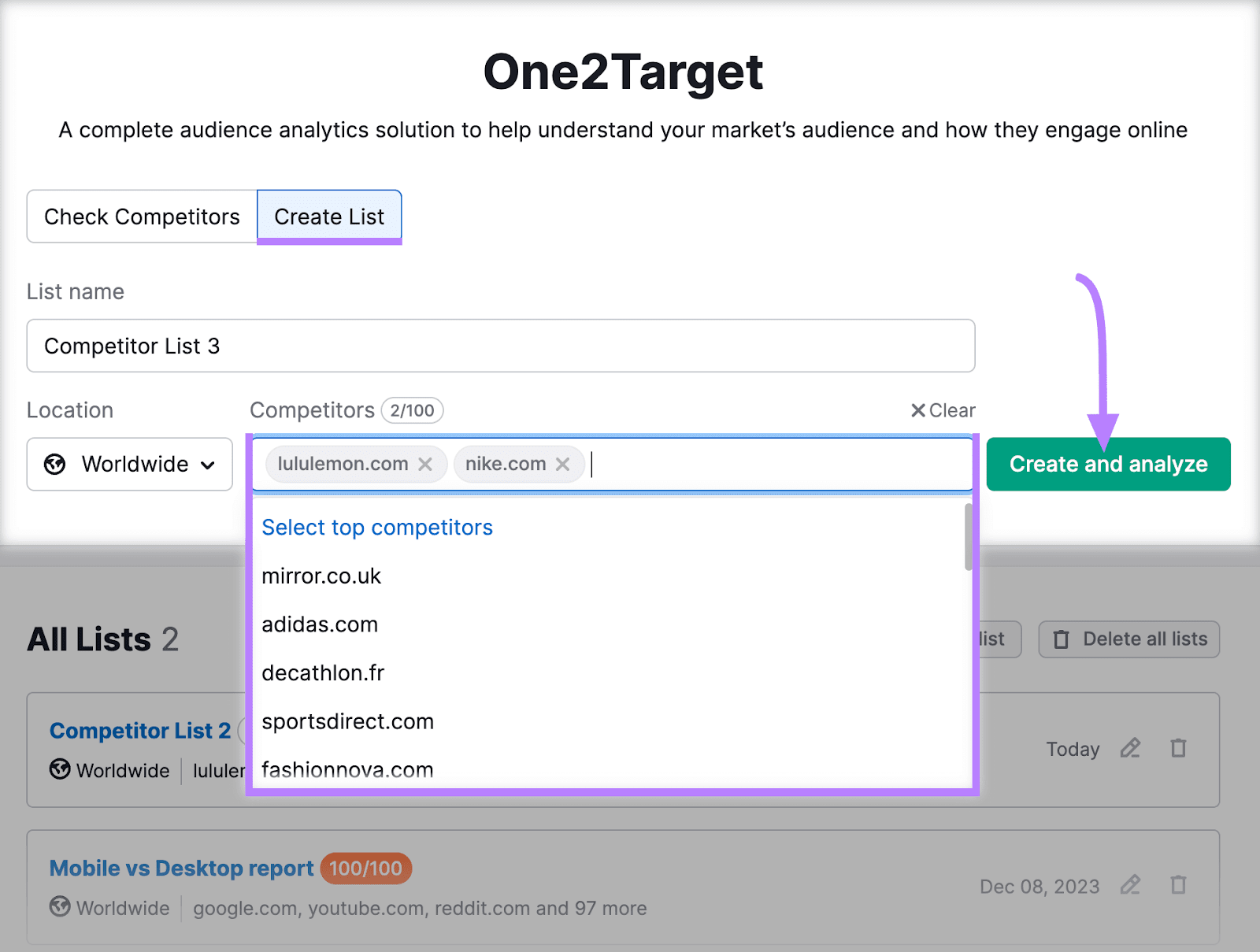
One2Target breaks down audience information into the following categories:
- Demographics: Site visitors by age, ***, and location
- Socioeconomics: Relevant information about household income, education level, and more
- Behavior: Other sites your audience visits and their preferred online shopping device
- Audience Overlap: Where you have the best chance of engaging your audience
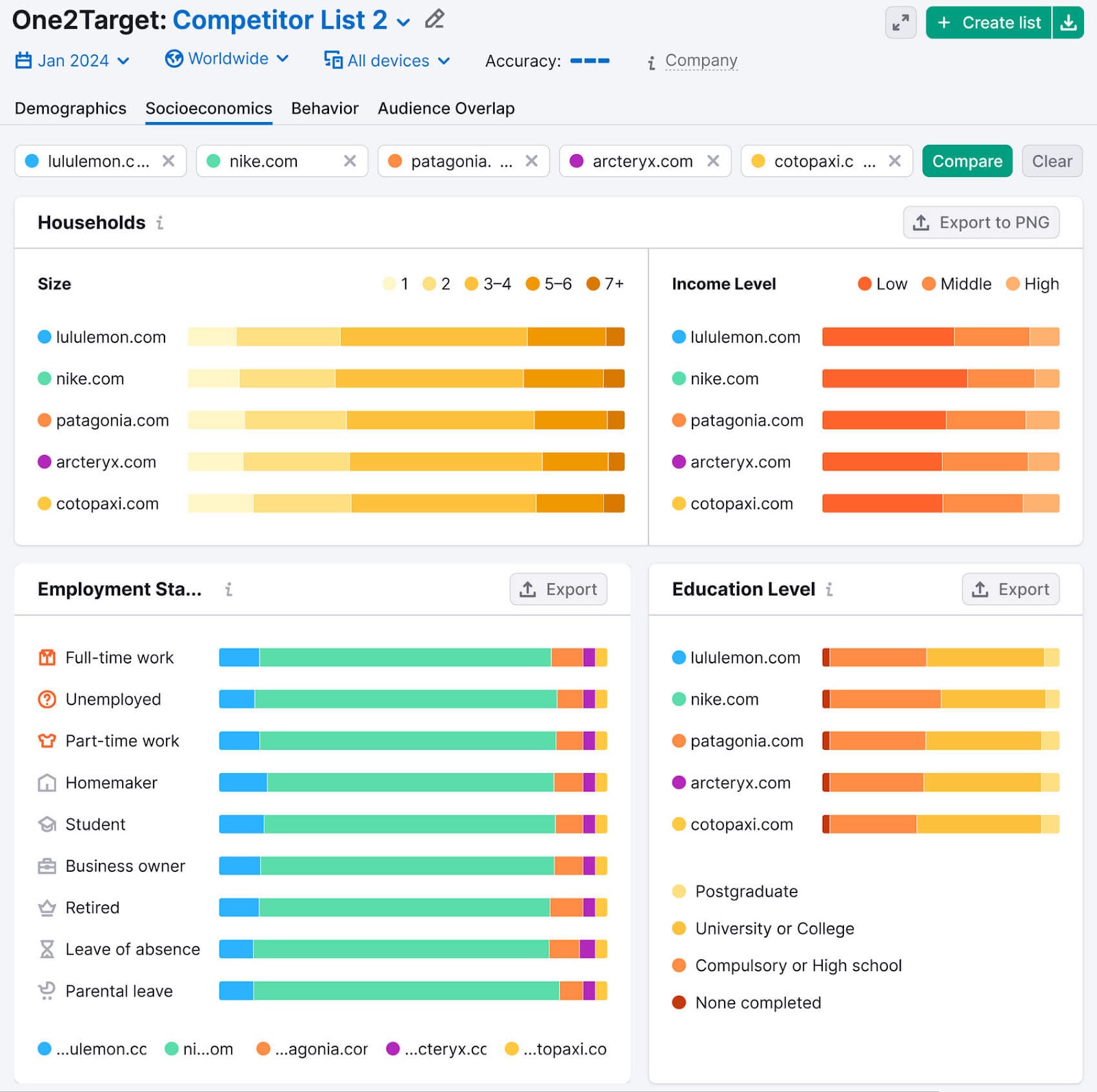
Use this data to create targeted content.
Informative content could be what separates you from the competition. And helps boost your rankings.
This includes:
- How-to guides
- Product demonstrations
- Expert reviews
- Comparison guides
- Email marketing based on browsing and purchase history
Outdoor retailer Zorali makes it easy for customers to make informed purchases.
Their online content includes outdoor guides, user-generated content, product reviews, and instructional videos. To create an excellent customer experience at every stage of the funnel.
This product page for their best-selling backpack features multiple clear images and a product review video.
And answers all the questions a potential customer might ask when shopping for a backpack.
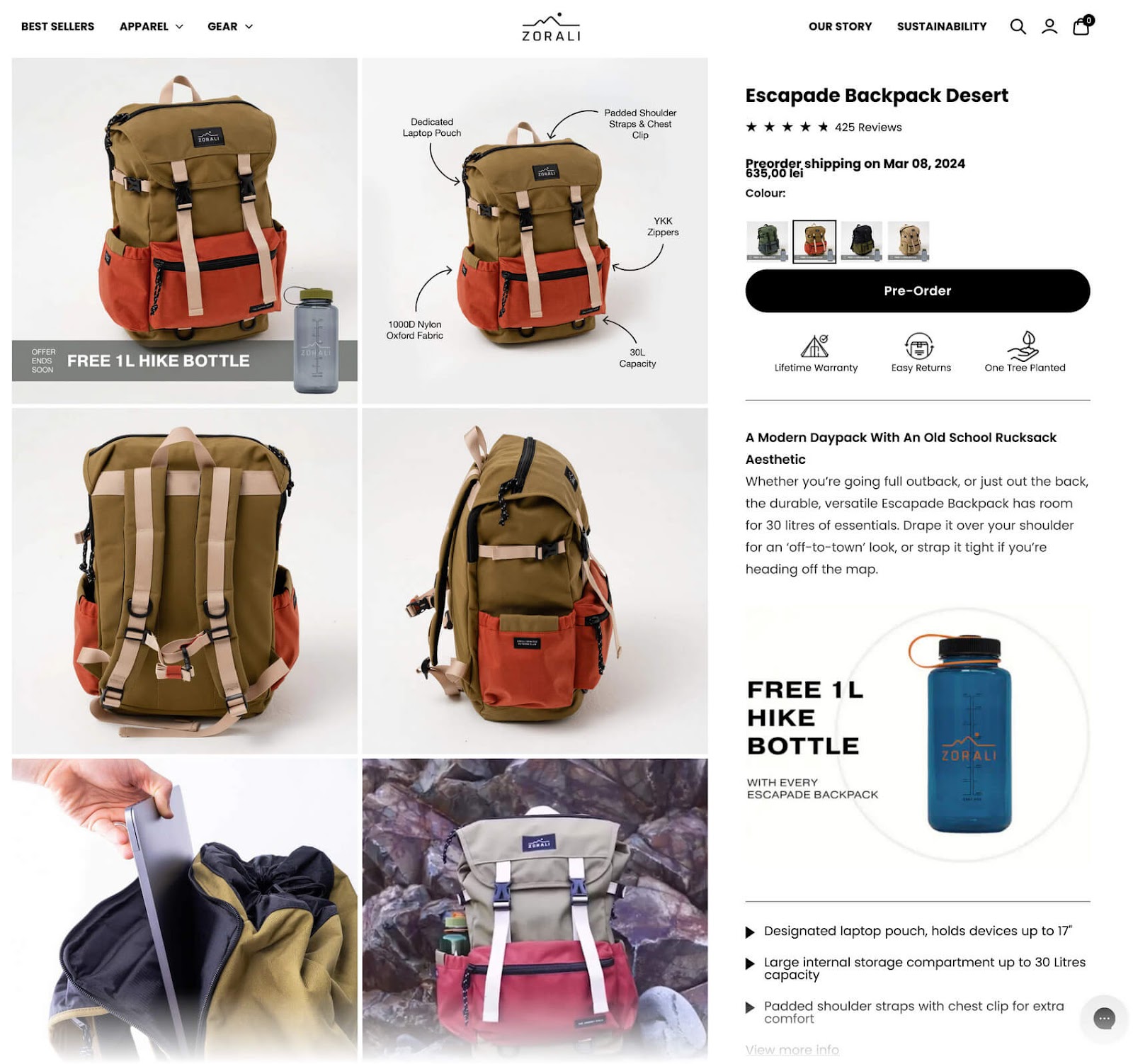
3. Improve Ecommerce Customer Support
Leaving customers wondering how to contact you or find important information sends a negative message.
Your customers may interpret your lack of transparency as a lack of concern for their shopping experience.
Here’s how you can provide better support:
- Post privacy policies and preferences: Include a link to your privacy policies in your footer
- Create a clear return policy: Make it accessible in several places on your website. Like the footer, product page, and shopping cart.
- Be upfront about shipping rates and delivery times: Offer this information early in the checkout process. So there are no surprises in the last step of checkout.
- Provide live package tracking: Take advantage of third-party apps if necessary to keep consumers informed
- Highlight business values: Share your company ethos throughout your website for values-based consumers
- Offer store locators: If you have physical locations, include a live map locator for easy searching
- Provide a product locator: If you sell your products in physical stores, give consumers the opportunity to shop local
- Implement a chatbot: A chatbot provides instant assistance. And can often resolve issues without escalating them to a live support person.
4. Simplify the Buying Process
Streamlining the buying process with a single-page checkout can reduce friction. Forcing shoppers to make too many decisions—like clicking three pages deep to enter a credit card—can increase the chances of cart abandonment.
A concise and straightforward checkout experience may contribute to higher conversion rates.
Unique Vintage, a vintage-inspired fashion brand in California, uses a simple, one-page checkout. And doesn’t require account creation.
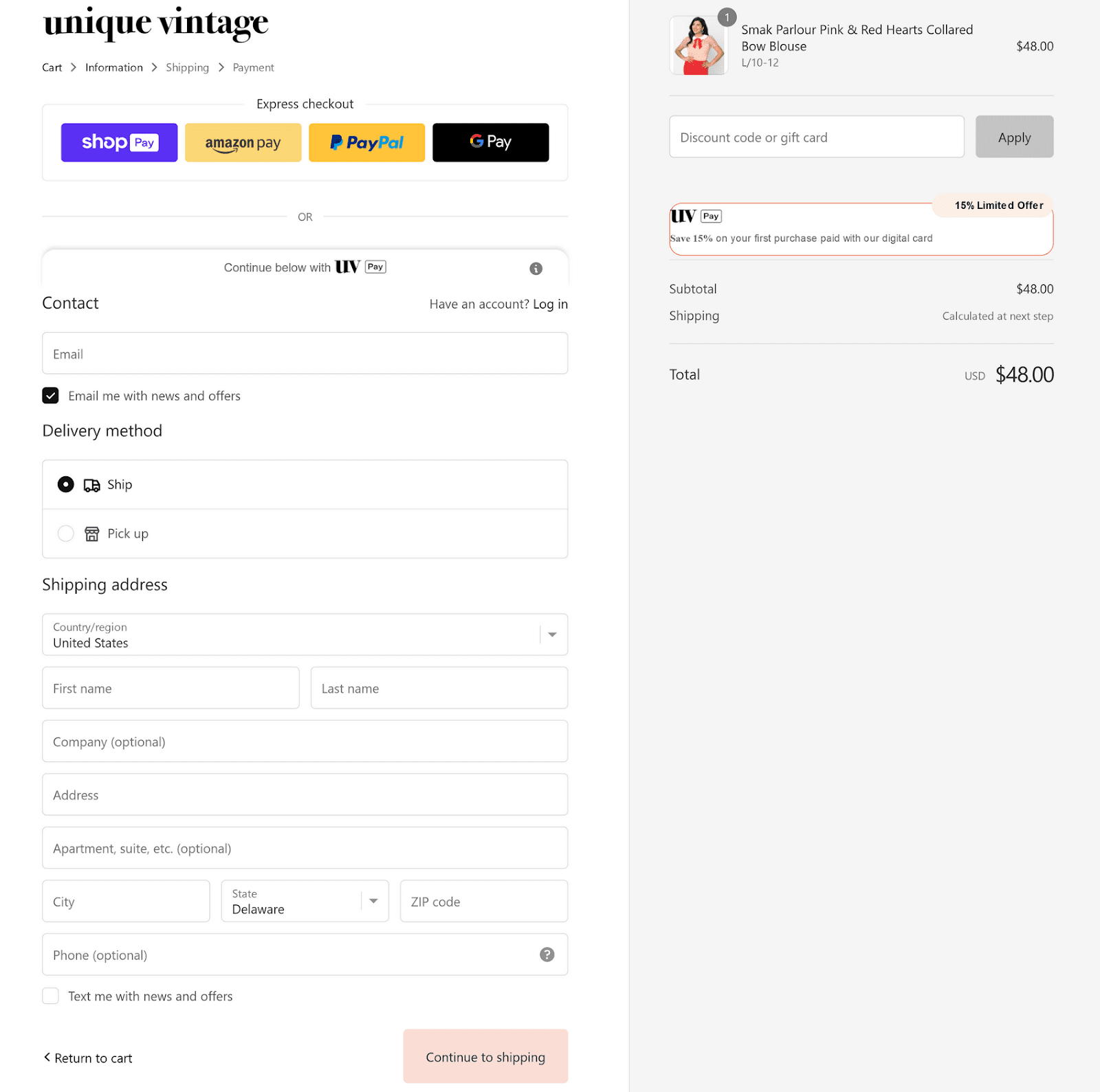
Give your shoppers the gift of a swift and hassle-free buying process.
5. Create an Inventory Management System
Managing inventory levels is critical in ecommerce. If customers repeatedly find their favorite products out of stock, they may get frustrated. And move on to a different brand.
How can you ensure this doesn’t happen on your website?
Inventory management software can track the flow of products. So you’re always stocked up on customer favorites.
Using “In Stock,” “Low Stock,” and “Out of Stock” flags to communicate inventory levels to your customers can also help manage expectations.
For example, if someone is looking for a bed and your inventory is running low, let them know.
The “Low Stock” warning will clearly communicate that if they want the bed, they should purchase it soon.
Chewy organizes these views for their customers in two ways:
- Adding an “Out of Stock” banner to items that are currently unavailable
- Placing all “Out of Stock” items at the very end of their inventory showings
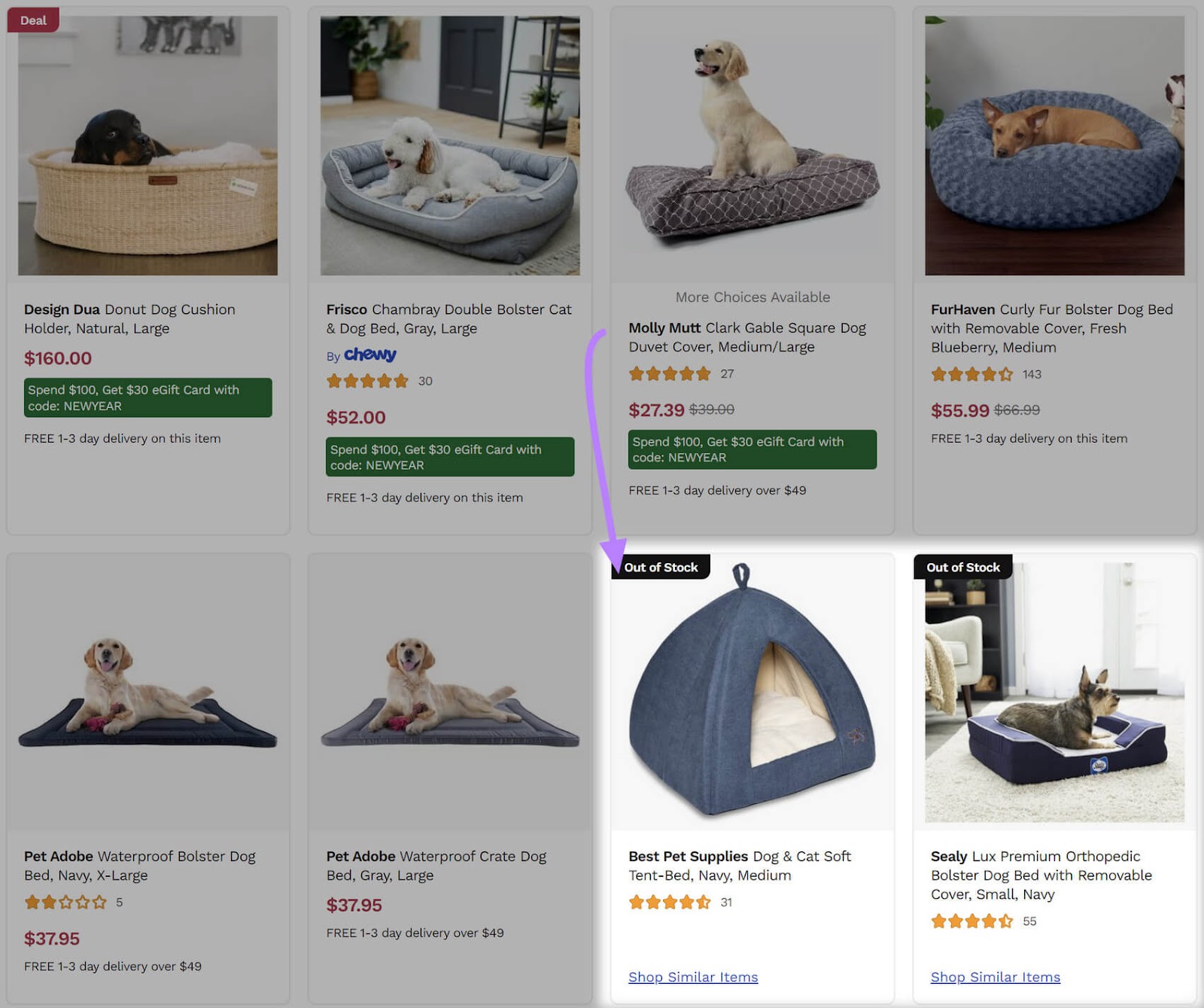
Transparency prevents disappointment and helps manage customer expectations.
6. Improve Return Policies
A customer-friendly return policy helps build trust and confidence. Although many ecommerce companies no longer offer free returns, an upfront return policy with clear instructions can contribute to a positive purchase experience.
But don’t stop there.
Anything you can offer for a hassle-free return process may be remembered. And appreciated.
Additional perks can contribute to a better experience. Like prepaid return labels for orders over a certain dollar amount. Or extending the return window during the holiday season.
7. Create an Omnichannel Presence
An omnichannel approach to customer experience can create a cohesive customer experience.
Omnichannel is when you create content for a variety of sales channels like:
- Your website
- Social media
- Google or Bing ads
- Email marketing
- Mobile app
Most importantly, your brand should have a consistent look and feel across all channels.
For example, shoe brand Vessi has a recognizable brand, no matter where customers shop or interact with the company.
They often use real customers in their marketing, feature outdoor landscape imagery, and use a consistent filter on all images.
Here’s a post from their Facebook page.

And a screenshot of their Instagram feed.

And a screenshot from their welcome email.
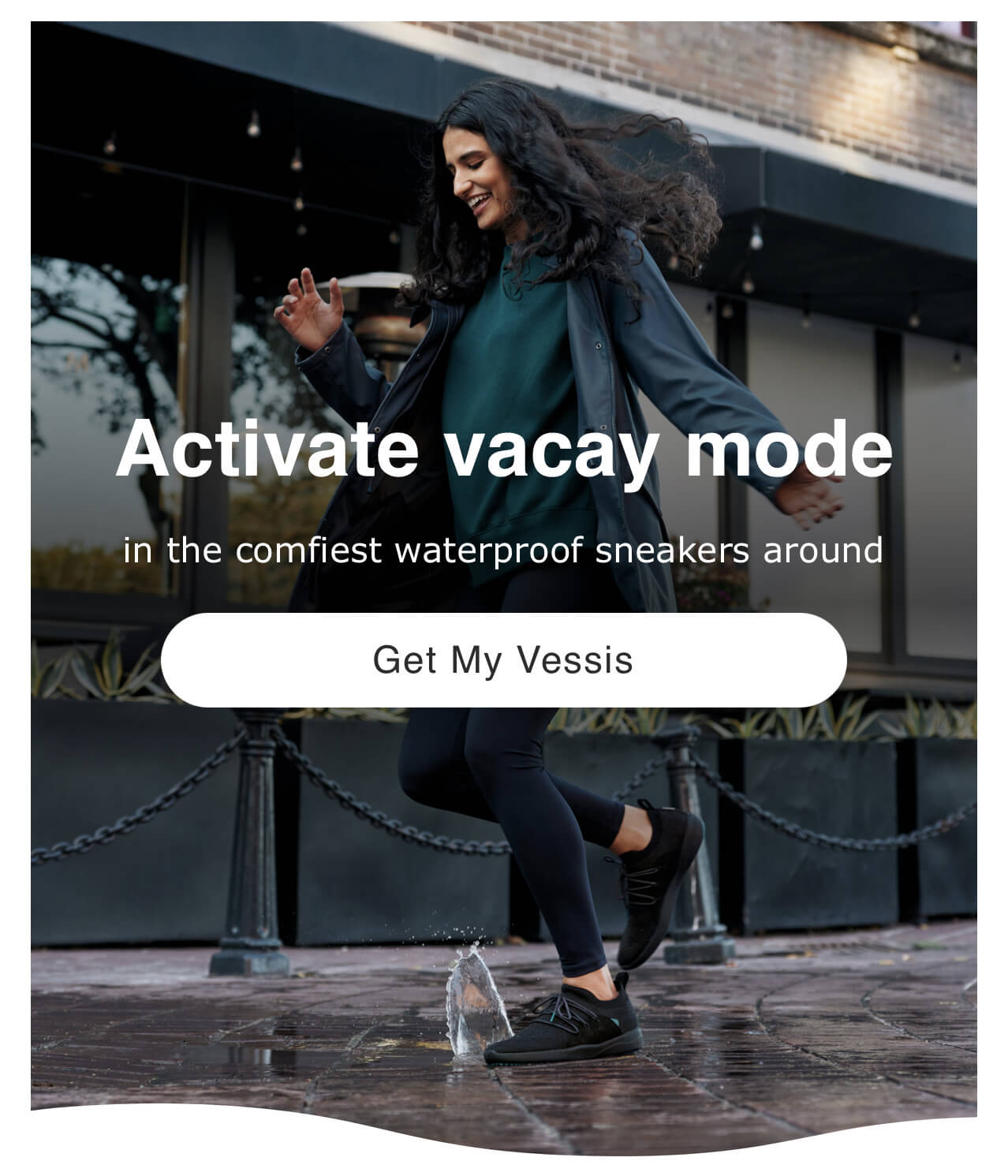
Each platform Vessi uses has a consistent look and feel. Helping ensure customers also have a consistent experience across channels.
Another advantage of omnichannel marketing is the opportunity to reinforce brand identity.
Customers expect the same level of service, pricing, and product availability. Whether shopping on a desktop computer, mobile device, or physical store.
8. Improve Delivery Time
Not every ecommerce retailer can offer fast and free shipping. However, expedited shipping options can keep customers happy.
Reducing delivery times can also increase customer satisfaction.
Even if you can’t offer two-day shipping like Amazon, aim to make it as fast as possible. And clearly state expected delivery dates and windows. To ensure customers know what to expect.
9. Provide Easy Search and Navigation
Providing the best ecommerce customer experience starts with allowing customers to transition from platform to platform seamlessly.
Many consumers switch devices when shopping. Sixty-five percent start out on their mobile phone. And 61% continue shopping on their laptop.
Customers need to find products quickly. And pick up their search where they left off, regardless of the device they started on.
For example, on the Nike mobile app, customers can add products to their favorites or cart. And if they switch to their laptop, their cart will still be there.
The user experience on the Nike app and website is consistent. So customers know what to expect. Regardless of how or where they access the content or products.
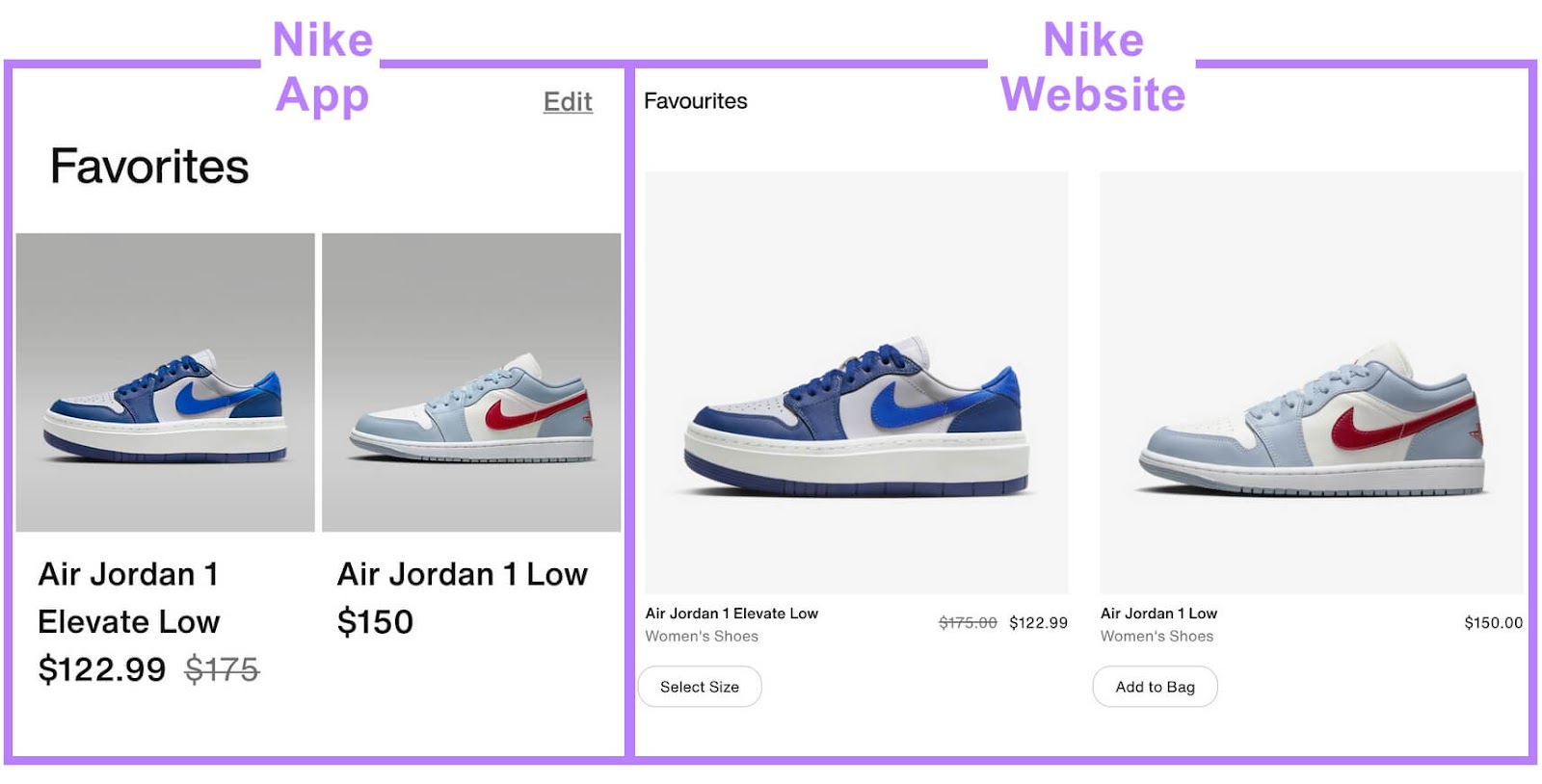
Implementing advanced search algorithms and filters can enhance the accuracy and relevance of search results. Well-organized categories and subcategories contribute to a seamless user journey.
For example, if you’re using the Nike app to search for running shoes, an advanced search algorithm will be able to show you the appropriate products.
Filters let you narrow search results even more. Like choosing your shoe size, color, or how much you want to spend.
Further reading: Ecommerce Website Optimization: 12 Strategies to Increase Sales
Challenges and Solutions in Ecommerce CX
Navigating the complexities of the ecommerce customer experience presents various challenges.
Here’s a deeper look into common obstacles. And potential solutions.
Adapting to Rapidly Changing Consumer Expectations
Consumer expectations evolve quickly.
Here’s how you can stay current with consumer expectations:
- Implement regular surveys: This could include post-purchase feedback, customer support surveys, and product reviews
- Create feedback loops: This involves looking for patterns in customer feedback, implementing changes, and analyzing feedback. So you constantly improve and evolve.
- Conduct market research: Use technology to predict what customers will want next. So you can be ready to meet their needs before they ask.
Monitoring Site Health
Customers want a unified experience across all channels. Whether shopping from a mobile app, website, or physical store.
However, manually monitoring your site’s health can be a challenging and time-consuming task.
Use the Site Audit tool to run regular audits. To help ensure your website is efficient, error-free, and properly optimized for SEO.
Site Audit can help you detect:
- Duplicate content
- Broken links
- SEO issues like missing H1 title tags and meta descriptions
- Page load speed
To use this tool, log into your Semrush dashboard. Click the drop-down “SEO” under “Projects” on the left-hand navigation. Scroll down until you see “Site Audit.”
After clicking Site Audit, click “Create Project” in the upper right-hand corner.
Enter your URL and click “Create project.”
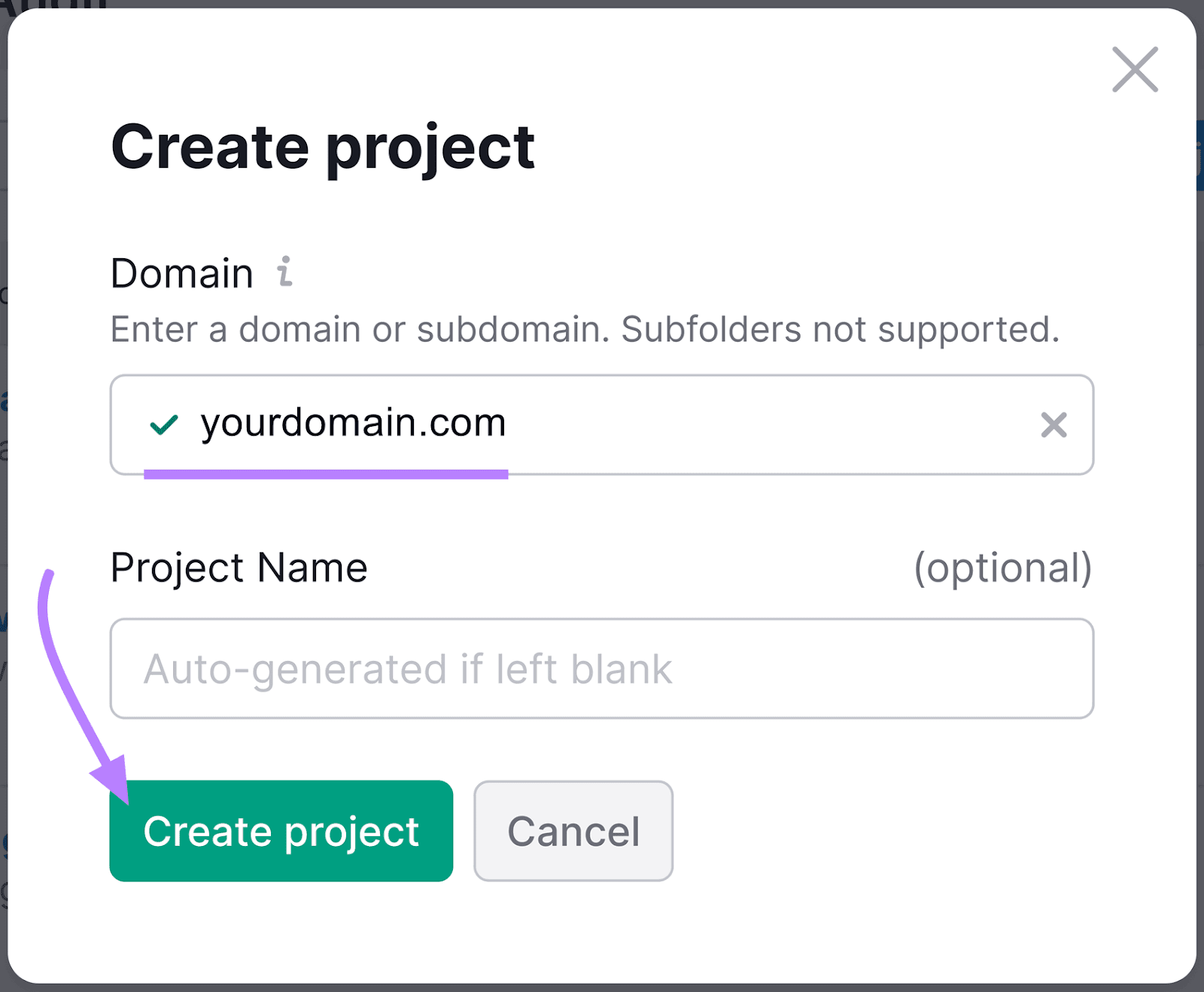
Once complete, return to your list of projects. Click “Set up” to run your first audit.
You’ll be asked to configure the number of pages you want checked. And the crawl source. This can be your website, sitemap, or URLs from a file.
The audit can take up to 24 hours, and you’ll get an email when the audit is complete.
Once complete, click on your URL in the list of projects and view your audit.
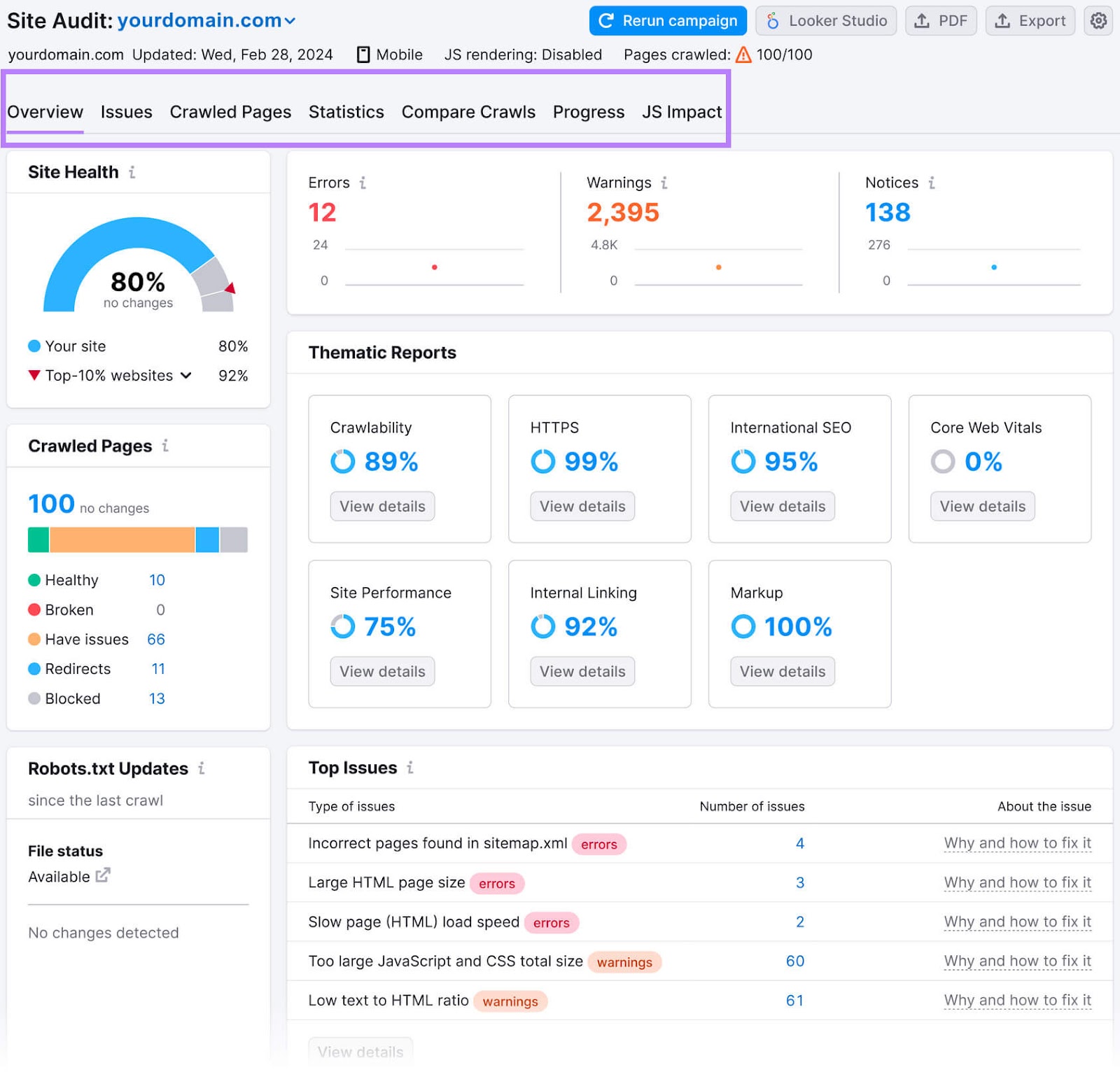
Click through the tabs at the top, starting with “Overview.” To view issues with your site in more detail.
Head to your website to fix any problems detected. This can help improve the ecommerce customer experience.
Personalizing Customer Interactions at Scale
Making each customer feel special can get challenging as your ecommerce business grows.
However, using smart tech like data analysis and AI can help predict customer needs. And allow you to connect with multiple customers in a personal way.
AI chatbots can chat with customers like a friend. They can answer questions, recommend products, and help with orders.
As your store grows and you can no longer manage a live chat, a chatbot can still make each customer feel heard. And valued.
Machine learning can help predict what your customers might like. It can make product recommendations based on previous visits, purchases, and search queries.
Implementing Data Privacy and Security
Letting customers know how you keep their data safe can make them feel more secure shopping with you.
- Use strong security measures. Like Secure Sockets Layer (SSL) encryption to keep data secure and unreadable by hackers.
- Hire a cybersecurity expert to check your website for vulnerabilities periodically. So you can find and fix any weak spots.
- Stay updated on rules about keeping customer data safe. Like GDPR in Europe and privacy laws in California.
- Put your privacy policies where customers can easily find them on your website
Further reading: What Is a Data Strategy and How Do You Create One?
Create an Excellent Ecommerce Experience with Semrush
Providing an exceptional ecommerce customer experience is just the start. To remain competitive, continually adapt. And refine your strategy.
The key to success lies in a proactive approach. Seek customer feedback, analyze performance metrics, and stay ahead of industry trends.
Site Audit and Traffic Analytics can help. Stay on top of website issues, keep tabs on competitor strategies, and gain insider target audience knowledge. For more effective marketing campaigns.
Source link : Semrush.com
